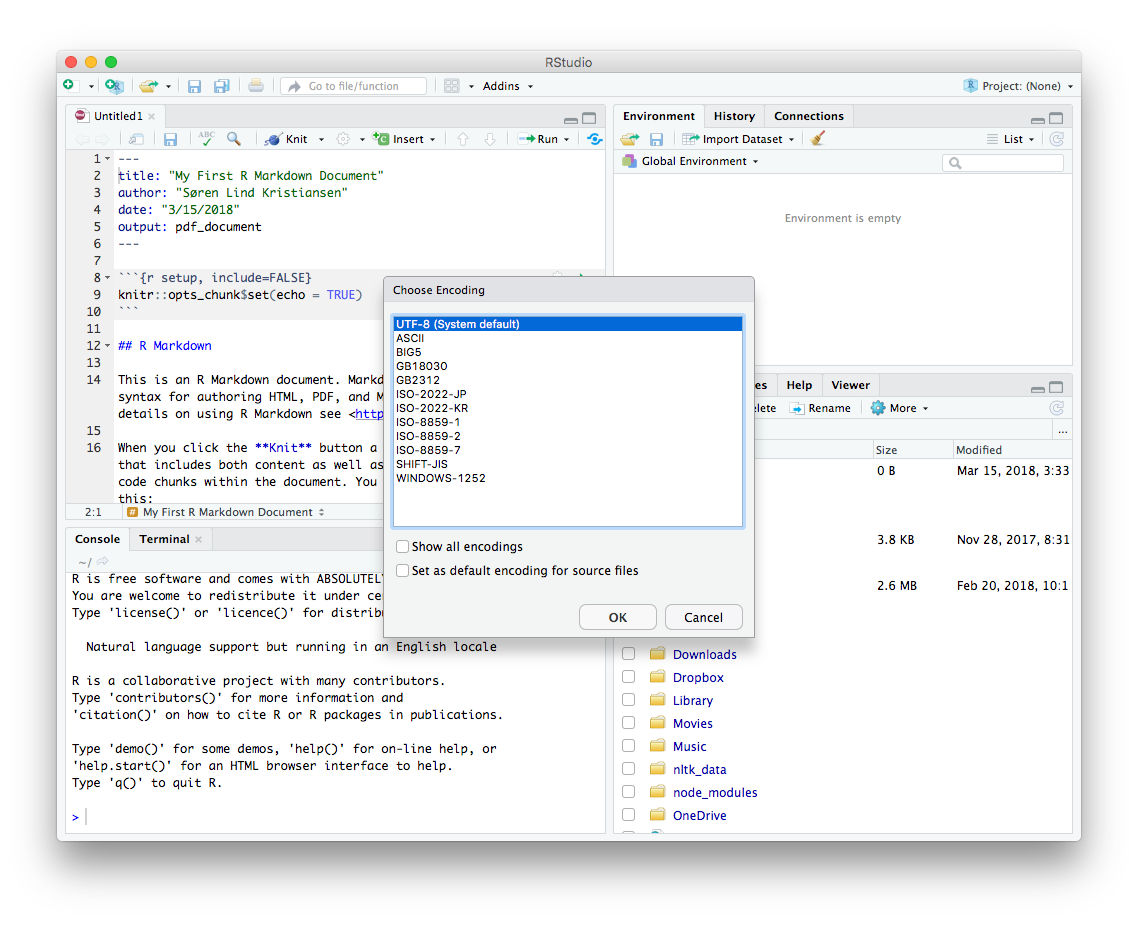
- #Using latex in rmarkdown how to#
- #Using latex in rmarkdown pdf#
- #Using latex in rmarkdown full#
- #Using latex in rmarkdown code#
#Using latex in rmarkdown code#
To achieve this, use bothĬol.names and escape = FALSE. By default, Pandoc will preserve raw LaTeX code in Markdown documents when converting the document to LaTeX, so you can use LaTeX commands or environments. I was also interested in implementing column names with specific lineīreaks, which is a bit more complicated. Using LaTeX color specification from the xcolor package - this specifies a mix of 15% gray Stripe_color = "gray!15" species the stripe color Implements table striping with repeated headers for tables that span Latex_options = c("striped", "repeat_header") Position = "left" places table on left hand side of Linesep = "" prevents default behavior of extraĪdditional styling options are specified with Longtable = TRUE handles tables that span multiple Other arguments, and are described in moreĭetail in the help file of kableExtra::kbl().īooktabs = TRUE is generally recommended for Many of knitr::kable() arugments are passed as
#Using latex in rmarkdown pdf#
Here are options I used to create a basic table with default columnįigure 3: Raw data table PDF output with default column A highly surprising fact to LaTeX beginners is that figures float by default: even if you generate a plot in a code chunk on the first page, the whole figure environment may float to the next page. rmarkdown will preserve the text, code results, and formatting contained in your original. You can even turn the file into an HTML5 or PDF slideshow. Rmd file into an HTML, PDF, or Microsoft Word file. Route through Ĭreates a page break for each new numbered top level section. PDF documents are generated through the LaTeX files generated from R Markdown. The rmarkdown package will use the pandoc program to transform the file into a new format. If you want to include a comment in your R markdown. This sounds complicated but once you have the glue written, it simplified table handling enourmously and also permits very useful manipulations like table arithmetic. You and me both, Charlie! This is tricky. You can, however, use a symbol to comment code inside a code chunk as usual (more about this in a bit). The idea was to write tables in markdown format, process them using R and output them using xtables back to the LaTeX document. Require numerous external packages and plug-ins in order to output the So far every package I have found seems to Maybe there’s a better way to this with pandoc.Library ( tidyverse ) library ( kableExtra ) library ( gtsummary ) library ( palmerpenguins ) BackgroundĬan anyone point me to a good R package that can create tables thatĪre easily outputted in PDF. You have to escape the \ character that precedes each of the references to mu, bar and sigma. That piece of code assigns names to the propdata object the desired syntax … err … sort of the desired syntax. Names(propdata) <- c("n", "$\\mu_$", "$E(s^2)$") which output format to use (HTML, LaTeX pdf, etc.) overall appearance of the document adding other files to add content or style the document.
#Using latex in rmarkdown full#
# assign names of dataframe with latex syntax Its kind of difficult to do this in reprex, since there is a Rmarkdown file (which I could not reprex the full contents) and then the Rmarkdown Rendering Script that is used to render the different reports by center. Your wish to use the plotly exports in a Latex generated PDF is likely to be.


Sims_var <- lapply(sims, function(x) apply(x, 2, var)) I like using Plotly (plotly express) in my Jupyter Notebook because I dont. Use a wrapper for LaTeX instead, like R Markdown. Sims_mean <- lapply(sims, function(x) apply(x, 2, mean)) Luke: 8/3/92 2:24 PM: I am trying to use footnote symbols (like asterisks and daggers) instead of the. Sims <- lapply(n, function(x) replicate(K, rexp(x, lambda))) The code below demonstrates one way to get the pander table to output the column names with LaTeX syntax. The syntax for these LaTeX symbols gets trickier when run inside a chunk (i.e. block of R code). And there are plenty of examples of using LaTeX in RMarkdown as well. There are plenty of LaTeX cheat sheets like this one to choose from.
#Using latex in rmarkdown how to#
I just spent ~ 30 minutes figuring out how to include LaTeX symbols … in a Pandoc table column header … in an R Markdown document. Without see R code generating a fake Tableobject and a whole rmarkdown file to test it, is hard to guess what you are trying, but anyway my advice is not make a LaTeX table with R chunks code in every cell, but construct first the table as a R dataframe (if Table is not already this) and then export the whole dataframe to LaTeX using xtable or kable. R Markdown: is a variation on markdown that is specific to R - it allows you to write a document using markdown to produce text and to embed R code and display.


 0 kommentar(er)
0 kommentar(er)
